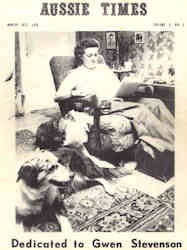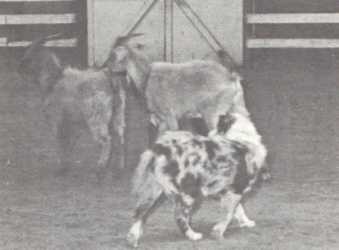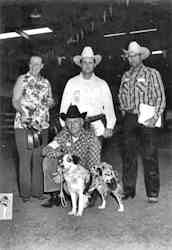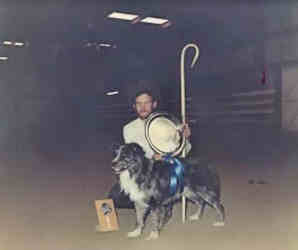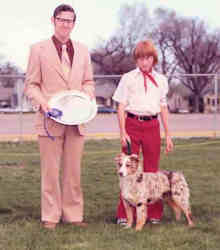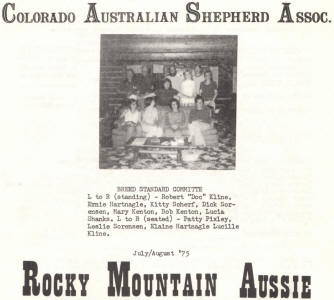 |
||
|
Education: Books, Videos & Herding Clinics
|
The History of The Australian Shepherd Club of America
O nce again, the Aussie Times gets a new look. Beginning with the April issue, the new ASCA logo appears on the cover as well as the notice: BREED CLUB REGISTRY Established March 10, 1972. Proudly displayed, this was a very significant step for the breed, which was to become the single largest Breed Registry in the country.
The Editors Note "The Aussie Times is a bit late in being put into circulation this time. This was due to the tremendous work - load which came from getting the Breed Club Registry set up (all of this work is completed beyond waiting for the printing to be completed on the Litter and Individual Registration Certificates)."
Aussies were being exhibited extensively in the Western United States with significant numbers of shows and large entries at the various events. Aussies competing at sanctioned matches quite often competed in the Group against AKC breeds.
There is interest in AKC recognition. Phillip Wildhagen, ASCA's Eastern Representative represents ASCA as they pursue a level of communication with officials within AKC. Phillip Wildhagen reports the fact that the Australian Shepherd "is relatively unknown in the East."
WORKING STOCKDOG CERTIFICATION - In Elsie Cotton's own words (Elsie was the ASCA Vice President acting as President, due to Gwen Stevenson's heart condition):
Steve Stephenson was appointed Stockdog Certification Chairman. In a letter and in a report that appeared in the August 1972 issue of the Aussie Times (Vol. 4. No. 2) he wrote:
He also said,
The Winter 1973 - 1974 Aussie Times was dedicated to Gwen Stevenson for her nine years as ASCA President (1963 to 1972) and member of the ASCA Board of Trustees in 1972 until the time of her death. She passed away late October in the Fall of 1973.
In the Winter 1973 - 1974 issue of the Aussie Times Steve Stephenson writes:
The Stock Dog Fanciers of Colorado hosted the first ever All-Breed Cattle, Sheep and Duck trial. The trial was held at Jerry and Sharon Rowe's farm in Broomfield Colorado. My father, Ernest Hartnagle was one of the judges.
Jerry and Sharon Rowe were highly instrumental in organizing the SDF trial. In 1973, Mary McDonnell who did publicity work for the group wrote:
She also wrote:
We invited Bob and Jean Carrillo to come see the trials. It was from these humble beginnings that the actual Stock Dog Program was birthed.
Bob Carrillo was appointed Stock Dog Chairman at the First Annual ASCofA National Membership Meeting April 7, 1974 in Chatsworth, California. Billie Jean Newman was President, Steve Stephenson, Vice President, Walter Lamar, Phillip Wildhagen and I were on the Board of Directors.
In a report that also appeared in the 1974 Spring, Aussie Times (Vol. 6. No. 1) in "Notes from the ASCofA Stock Dog Chairman", he wrote this:
In the same report he wrote:
Shanks Ginks, Winners Bitch at the 1974 Arizona
Annual Silver Specialty in 1974
Bob was invited to judge the trial, along with Carol Schmutz and Walter Lamar. Back in those days the judges paid all their own expenses (without reimbursement) to get the ASCofA Stock Dog Program off the ground. Classes that were offered were Novice and Open Goats, Novice and Open Cattle, Novice and Open Poultry with a special Subnovice Poultry class that was worked on lead for people who had never worked stock before.
Bob continued to report:
Bob also wrote:
Photos from the Colorado Australian Shepherd Association Trial in Colorado, May 11, 1974:
Joe Hartnagle, Colorado's 1975 ROM Junior Handler
pictured with Las Rocosa Gotta Be Good
Carol Ann Hartnagle & Dalia
The Match and Show News
states: Ch Bright Future of Windermere, but it was actually
1975 Highlights:
ASCA Breed Standard - On
January 3, 1975, the ASCA Board of Directors appointed the Colorado
Australian Shepherd Association as the breed standard committee,
under the chairmanship of Walter Lamar. Breed Standard Committee - 1975
A proposed outline of the standard was sent to Aussie breeders, veterinarians, and affiliate clubs for their opinions and suggestions. After a careful study of all the returned forms, we hoped to come up with a standard acceptable to all, and worthy of the Australian Shepherd.
Robert E. Kline DVM, president of the Colorado club wrote, “We have been given the honor and awesome responsibility of writing a Breed Standard for the Australian shepherd by the ASCofA.” As Dr. Kline stated that perhaps “Standard of Perfection” was a better title and used by many livestock groups as the title of the document that states their ideals or goals to strive for in their breeding programs.
“We have had a special meeting and have scheduled a plan of action. By the time you read this, all affiliates will have an outline in hand and have been asked to fill in comments as they think the standard should be. We ask every club to take time to seriously thin about and discuss each portion of the standard outline in detail. Please keep in mind at all times, this standard is for the Aussie in all parts of the country. The filled in standard outline will be carefully considered in a democratic manner and our club hopes to come up with a standard acceptable to all; one that is precise and understandable and of value in advancing the quality, usefulness, and beauty of our beloved Aussie. I assure you that we do not take this responsibility lightly and hereby dedicate our club along with Walter Lamar as Chairman to this task. We commend the other affiliates who have worked hard and have done a fine job on show rules, by-laws etc.”
Mexican Recognition - June 25, 1975 Phillip C. Wildhagen informed ASCA affiliate clubs, IASA and its affiliate clubs that Australian Shepherds were now recognized by Mexico for full registration privileges and eligibility to compete for Mexican obedience and conformation titles. “The ASCA Breed Standard will be used by the Association Canofila Mexicana and will be updated upon completion of the current Standards Committee activities.”
The task of writing the Standard of Perfection was taken on with modesty and a sense of democracy. Scientific data on the percentage of existing traits in the breed was used. On September 9, 1975, the ASCA breed standard committee sent a copy of the “Australian Shepherd Breed Standard Rough Draft – Revised 8-9-1975” and the “Supplement of Annotations to the rough draft.” Firstly, the affiliate clubs were contacted by questionnaire for their suggestions on writing the standard. Following the receipt of their comments, the initial drafts of the standard and supplement were written. Secondly, the drafts were submitted to various outside experts (veterinarians, anatomists, canine kinesiologists) to insure proper anatomical and physiological accuracy, as well as nomenclature used on the dog fancy in general. After this critique the rough draft was rewritten. Thirdly, the affiliate clubs were again contacted and asked for their comments on the revised rough draft and supplement. Following receipt of the affiliate club critiques, these documents were again reviewed and revised into their present form. The supplement was written to explain and amplify the reasoning behind the language used in the standard. According to Dr. Kline, “We eliminated every unnecessary word. Any work that didn’t mean something and could possible confuse people was taken out.”
To quote Dr. Kline, “Contrary to the beliefs of many, such a standard is not a textbook, but rather an outline describing structure, breed characteristics, color, size, uses, etc. put down in as precise and accurate a manner as possible. In order to perfect such a document without in fact ending up with a textbook the size of a physician’s anatomy book, it is predisposed that many people using such a standard, have a working knowledge of animal traits, vocabulary, and methods used by the industry to enable them to understand and interpret said standard so as make it a usable instrument. For those not so familiar with these things and wanting to use the standard, such persons owe it to themselves to seek out knowledgeable breeders and judges, texts, etc., to avail themselves of such knowledge. For accuracy sake, it precludes a standard to be written for the beginner or novice.
By the time the standard was sent out to the membership for total approval thereof, it would have been to the affiliate clubs twice, outside experts once, and passed by the official board in accordance to the original plan of action. It was the committee’s aspiration that it would be worthy of the membership’s confidence and serve as a useful tool to preserve the balanced, beautiful, useful, and versatile Australian Shepherd.
ASCA/IASA Unification
- The minutes for the national meeting on November 28, 1975 included
the formation of the ASCA/IASA unification committee
During the meeting with IASA representatives to review the proposed breed standard for all Australian Shepherds, both clubs (ASCA and IASA) were hopelessly deadlocked over the disqualifications of the overshot AND undershot bites. In the proposed ASCA breed standard, BOTH the overshot and undershot bites were listed as disqualifications. The IASA wanted to allow what they called an “inverted scissors” (undershot) and overshot bites. IASA offered a compromise. They would accept the disqualification on the “inverted scissors” in return for ASCA’s allowance for the overshot bit to 1/8” (one eighth) of an inch without disqualification.
If ASCA did not agree to this compromise, IASA vowed to boycott the entire proposed standard. In an attempt to unite the breed and have all Australian Shepherds exhibited under one standard and be able to merge the two most powerful clubs in the nation into one unique organization, the ASCA RELUCTANTLY agreed to their proposal.
Yearbook - Although not assigned an ASCA subject number, a year book was discussed.
ASCA Election - Results of the ASCA election from the national meeting in Phoenix, Arizona were announced:
1976 Highlights:
According to the show records - As of January 15, 1976, Australian Shepherds were shown at 176 shows in 22 states in the previous year (1975). The registry numbered almost 3,000 dogs. A new point schedule was assigned based on the AKC system of dividing the country into four divisions according to the total number of Aussies exhibited: Division one - including Utah to Wisconsin showed 1 to 250 Aussies. Division two -Michigan, Colorado, and Nevada - exhibited 251 to 500 Aussies. Division three - Arizona showed from 501 to 1,000 Aussies. Division four - California exhibited over 1,000 Aussies.
Registry Reopening - During the nation’s bicentennial year, the registry reopening rules stated: “The registry shall remain open for inspection of dogs for one year beginning January 15, 1976 with an option for the ASCA Board for extending the inspection period annually.” Only purebred Australian Shepherds were eligible for ASCA registration. Viewing panels were set up in areas with ASCA affiliate clubs, consisting of a panel of five people. Names and qualifications of each proposed member were approved by the ASCA BOD. An appeals panel was also created for final evaluation of any Australian Shepherd refused.
National Stock Dog Registry - A fire destroyed the home and offices of E. G. Emanuel, longtime friend of the Aussie and registrar of the National Stock Dog Registry, a division of the International English Shepherd Registry in Butler, Indiana. The fire caused total destruction of Ed’s home, but the records stored on microfilm were safe.
Breed Standard / ASCA/IASA: In the President’s report to the membership (February 23, 1976), it was noted the Breed Standard was approved by the IASA board of directors. Preparations were being made to present the well-written, concise document to the membership of both organizations for approval.
During this time, the ASCA/IASA liaison committee was preparing material for negotiations in the goal to unify both organizations under one umbrella.
The President’s Report that appeared in the Spring issue of the Aussie Times stated, “ASCA is moving at a tremendous pace. To date, over forty business issues have been presented to the Board for action. The heavy workload commands efficiency. It requires approximately thirty days to complete an issue by correspondence for finalization.”
Obedience and Tracking - Rose Spicuzza, ASCA Show Secretary stated, “I am constantly being made aware of how many Aussies are placing in obedience classes with large entries. Many are taking first place [awards] with beautiful scores, 199.5, 199, and 195.” In regards to tracking, Rose said, “Just as not all dogs are natural tracking dogs, not all Aussies are natural tracking dogs. However most dogs, and more than the average number of Aussies can earn their T’s [tracking titles]. You don’t have to teach a dog to track, but you do have to teach a handler to read his dog and handle his tracking line.”
Junior Handling – In the summer of 1976, a merit program for junior handlers was under development since was recognized that the junior handlers of the day would become ASCA’s future leaders.
Canine Eye Registration Foundation (CERF) – The fancy was introduced to the Canine Eye Registration Foundation. CERF served as liaison between veterinarians specializing in eye disease detection and the purebred fancy. Its multi-purpose procedures were devised with the approval of the American College of Veterinary Ophthalmologists. CERF functions as a registry for clear-eyed dogs, but at the same time serves as a center for the accumulation of vital statistics on both normal dogs and dogs affected with hereditary eye disease, according to breed and disorder.
Breed Standard / President’s Winter Report - Members learned that the voting membership passed all sections of the breed standard in excess of the required two thirds majority, with the exception of the section describing color and its disqualifications. Since all comments of the active, voting membership had been received with the ballots, the ASCA board of directors made the required changes to this section using the comments received from the ballots cast.
Letter regarding white on ears - Dated March 26, 1976. “Today, I received a letter from Marcia Hall concerning, among other topics, the detrimental effect of disqualifying Aussies due to white on their ears. The sentence, “Both eyes and both ears must be entirely surrounded with color other than white” was added to the old breed standard in 1973 in order to clarify the undesirability of homozygous merles (white merles) in our breed. The proposed new standard DISQUALIFIES dogs with ‘eyes and ears not entirely surrounded and covered with color other than white.’
“Marcia’s letter stated that ‘all of the foundation stock of a particular bloodlines…had a certain amount of white on their ears.’ Until I had read this, I had always associated white on ears with homozygous merles and had not heard of it appearing on normal merles. Marcia’s letter prompted me to take a closer look at all of our Aussies and I was somewhat taken aback to see that our male, Lowne’s Tuck of Coppertone (out of Flintridge lines) had a small streak of white on one ear. Tuck, as those who have seen him can attest, is an otherwise very well marked normal merle.
“The undesirability of white on ears was introduced into our breed standard in order to differentiate between homozygous and heterozygous merles. If white appears, and it does, on normal as well as defective merles, then the disqualification for white on ears does not serve its purpose and it should not appear in the new standard. If we allow prick and hound ears we should not disqualify for a spot of white on an ear unless this spot truly indicates that a dog is a defective merle. Apparently, it does not in many cases. I would hate to see any good individuals from our breed lost on the false premise of white on ears indicating defective white merles. Sincerely, Richard W. Lownes.”
Registry Rules – The registry rules were a topic of major discussion. The ASCA board of directors extended the registration inspection period for Aussies not yet registered with ASCA through 1977. All dogs that exhibited disqualifying faults, as described in the breed standard, would be eligible for registration, but would not be eligible for breeding. The registration certificate would be stamped “not to be used for breeding.” Therefore, any subsequent progeny would not be eligible for registration.
No dogs exhibiting a main body color of white were eligible for registration.
AKC Recognition - The pros and cons of AKC recognition was again a topic of discussion.
Show Secretary Report – Rose Spicuzza, the ASCA Show Secretary, reported: 29 Championships were earned in 1976 (38 Championships in 1975), 44 Companion Dog titles (35 - CDs in 1975), Eight Companion Dog Excellent titles (3 CDXs in 1975), Four Utility titled dogs (3 UDs in 1975), and one Tracking Dog (zero TDs in 1975).
© 2004 By Ernest Hartnagle & Jeanne Joy Hartnagle-Taylor
Copyright photos provided from the Hartnagle family archives.
|
|

